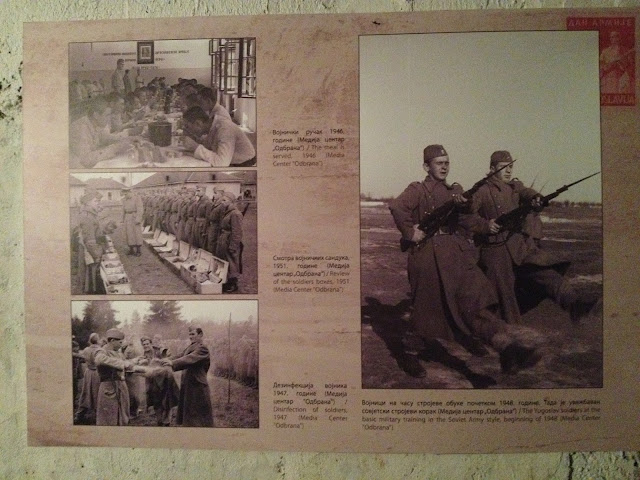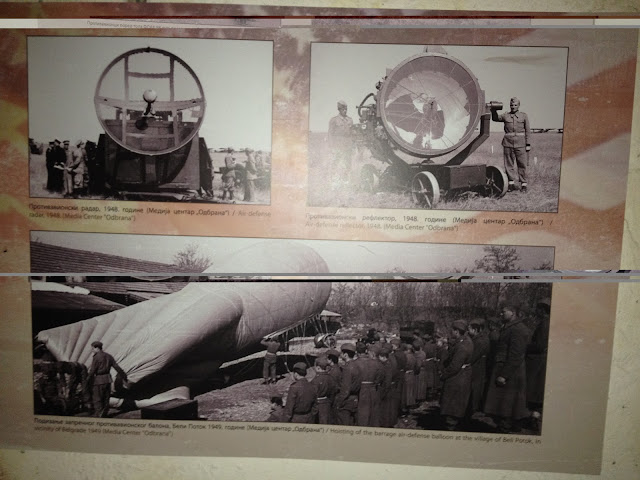My
recent post was about a short visit to the Esperanto museum in
Vienna. After Vienna, I came to Belgrade where I had the chance to
visit the Kalemegdan fortress, one of the town's most central
historical places. Before going to Belgrade, I remembered the video on
Youtube about a "discovery" made in 2008 when the bunker
was reopened, examined and later presented to the public.
According
to the Kalemegdan's official website the following information about
the bunker is stated: 1
Bunker
was built at the beginning of the 50s of the 20th century and it is
one of several hundred cannon, machine gun and other bunkers constructed in
this area. Due to the lack of documentation nobody can say for sure
when and why the bunker was made, however a date 10th or 18th of
October 1953 has been carved at the wall of the stairs leading to the
bunker, which leads us to the fact that it was built in the first
half of the 5th decade of the last century. The bunker was never used
for its original purpose.
The
bunker itself represents the early history of the Socialist Federal
Republic of Yugoslavia and the Cold War. As the Kalemegdan fortress
became a military object and the bunker became a "piece of a
puzzle" of the deteriorating relations between Yugoslavia and the
Soviet Union. This crisis between Yugoslavia and the
Soviet Union and other Warsaw Pact states became known as the "Informbiro crisis". For Yugoslavia, it meant that there was a risk of war and aggression. The role of the fortress Kalemegdan was to function as a position for
anti-aircraft batteries consisting of German-made Flak 88 heavy
anti-aircraft guns with 88 mm calibre.
Within
the bunker there is a gallery of photographs mostly taken during the
period 1948-1955 representing the contemporary developments such as
preparations for the air defence of Yugoslavia's capital. For more
information about the bunker, please visit the Kalemegdan's website and watch the video below.
"Somewhere between" East and West
Entrance
Drinking water
Storage room with a heating system
Stairs leading to the anti-aircraft position
The former anti-aircraft position sealed with concrete.


Conscripts arriving to barracks for military training.

Military service in the Yugoslav People's Army
within the Kalemegdan area

"Free-time activities". The possibility for the soldiers to play jazz was a political sign of changes in the society where such kind of music was considered as "American" in negative terms.
"We love Tito". At the end of the 40's and beginning of 50's the Yugoslav society still had problems with illiteracy. The soldiers were educated to write and read but also how to think ideologically by official policy and "Titoism."
Daily life in the military. Soldiers to the right are marching by the Soviet military regulations. During the crisis period, this practice was changed.
Political manifestations such as the elections and parade with sport events.
Military exercises. Soldiers to the right are participating in the exercise in West Slovenia. They are still wearing German-made steel helmets from World War II.
From left to right.
a) Soviet-made Il-2 Shturmovik light ground-attack bomber
b) Unknown WWI period artillery piece
c) Soviet-made T-34-85 medium tank.
d) Soviet-made self-propelled anti-tank gun Su-76
Yugoslav air-force. Equipped with contemporary modern American-made F-86 jet-planes which were used during the Korean war. Also, the American-made Sikorsky S-51 helicopters were delivered by USA.

Yugoslav war navy exercise.

American made equipment, as for example the M4 Sherman tanks, being delivered to Yugoslavia during the crisis and frozen relations with the Soviet Union.

Tito meeting with the emperor of Ethiopia - Hassie Selassie. Manifestations including meetings with NATO-representatives and British field-marshals Montgomery and Hardigan.

Yugoslav border guard and their Italian counterparts at the border and divided city of Gorizia/Gorica during the "Triste crisis" in autumn of 1953.
The time of crisis also lead to Yugoslavia making decisions to establish more of the internal arms industry and production. On the left side, the first Yugoslav-made jet-plane Ikarus-451M and below it the first domestic-made artillery piece, the B-1 mountain cannon with 76 mm calibre. To the right the Yugoslav-made T-34 under the name "A-1" seen during the Victory Day parade on 9th May.
Air-defence training within the Kalemegdan fortress with the German-made Flak 88 anti-aircraft guns involving other equipment such as air-defence radar and balloons.
References
1Belgrade Fortress. Military Bunker. Publication date: 2015-08-07. Downloaded: 2015-12-27. Website: http://www.beogradskatvrdjava.co.rs/?p=5654&lang=en:























Inga kommentarer:
Skicka en kommentar